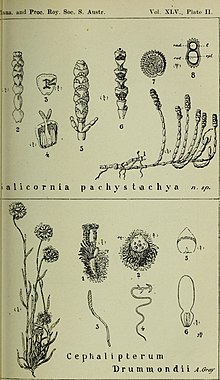
Salicornia is a genus of succulent, halophytic flowering plants in the family Amaranthaceae that grow in salt marshes, on beaches, and among mangroves. Salicornia species are native to North America, Europe, central Asia, and southern Africa. Common names for the genus include glasswort, pickleweed, picklegrass, and marsh samphire; these common names are also used for some species not in Salicornia. To French speakers in Atlantic Canada, they are known colloquially as tétines de souris. The main European species is often eaten, called marsh samphire in Britain, and the main North American species is occasionally sold in grocery stores or appears on restaurant menus as sea beans, samphire greens or sea asparagus.
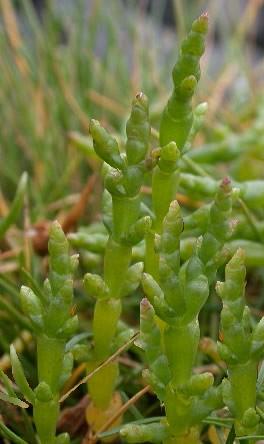
Samphire is a name given to a number of succulent salt-tolerant plants (halophytes) that tend to be associated with water bodies.
Sarcocornia is a formerly recognized genus of flowering plants in the amaranth family, Amaranthaceae. Species are known commonly as samphires, glassworts, or saltworts. Molecular phylogenetic studies have shown that when separated from Salicornia, the genus is paraphyletic, since Salicornia is embedded within it, and Sarcocornia has now been merged into a more broadly circumscribed Salicornia. When separated from Salicornia, the genus has a cosmopolitan distribution, and is most diverse in the Cape Floristic Region of South Africa.

The Salicornioideae are a subfamily of the flowering plant family Amaranthaceae. Important characters are succulent, often articulated stems, strongly reduced leaves, and flowers aggregated in thick, dense spike-shaped thyrses. These halophytic plants are distributed worldwide. Many are edible
British NVC community SM10 is one of the salt-marsh communities in the British National Vegetation Classification system. This community is found in coastal areas in the Solway Firth, south Cumbria, Lancashire, west and south Wales, Hampshire, The Wash and north Lincolnshire. There are no subcommunities.

The glassworts are various succulent, annual halophytic plants, that is, plants that thrive in saline environments, such as seacoasts and salt marshes. The original English glasswort plants belong to the genus Salicornia, but today the glassworts include halophyte plants from several genera, some of which are native to continents unknown to the medieval English, and growing in ecosystems, such as mangrove swamps, never envisioned when the term glasswort was coined.
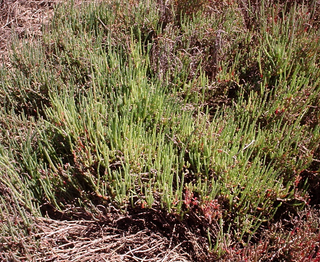
Tecticornia is a genus of succulent, salt tolerant plants largely endemic to Australia. Taxa in the genus are commonly referred to as samphires. In 2007, the genus Halosarcia, along with three other Australian genera was incorporated into the genus.

Salicornia quinqueflora, synonym Sarcocornia quinqueflora, commonly known as beaded samphire, bead weed, beaded glasswort or glasswort, is a species of succulent halophytic coastal shrub. It occurs in wetter coastal areas of Australia and New Zealand.
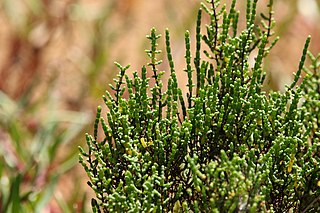
Tecticornia halocnemoides, commonly known as shrubby samphire or grey glasswort, is a species of succulent, salt tolerant plant endemic to Australia. It grows as a spreading or erect shrub up to fifty centimetres high. It was first published as Arthrocnemum halocnemoides in 1845, but transferred into Halosarcia in 1980, and into Tecticornia in 2007.

Tecticornia arbuscula, the shrubby glasswort or scrubby samphire, is a species of plant in the family Amaranthaceae, native to Australia. It is a shrub that grows to 2 metres in height, with a spreading habit. It has succulent swollen branchlets with small leaf lobes.

Tecticornia pergranulata is a succulent halophytic plant species in the family Chenopodiaceae, native to Australia. This plant is commonly tested in labs involving its C3 photosynthesis and its unique resistance to salinity and adversity.

In botany, succulent plants, also known as succulents, are plants with parts that are thickened, fleshy, and engorged, usually to retain water in arid climates or soil conditions. The word succulent comes from the Latin word sucus, meaning "juice" or "sap".

Salicornia utahensis, synonym Sarcocornia utahensis, is a species of flowering plant in the amaranth family known by the common name Utah swampfire. It is native to the southwestern United States, where it can be found in desert habitat, generally in areas with alkaline or saline soils, such as playas. This halophytic perennial herb or subshrub grows in low matted clumps of woody stem bases anchored to the substrate by rhizome systems. The stem grows erect into fleshy green branches. The inflorescences are within the distal parts of the branches, which are ringed with tiny flat flowers.

Salicornia europaea, known as marsh samphire, common glasswort or just glasswort, is a halophytic annual dicot flowering plant. Other common names include pickle weed, saltwort, and chicken toe. It is a succulent plant with high water content, accounting for its slightly translucent look. It is found near saline water in Europe and is edible both raw and cooked.

Microcnemum is a genus in the plant family Amaranthaceae, containing a single species, Microcnemum coralloides. It is a dwarf annual halophyte with fleshy, apparently jointed stems and reduced leaves and flowers. The two subspecies show a disjunct distribution in Spain and Western Asia.

Salicornia perennis, synonym Sarcocornia perennis, otherwise known as perennial glasswort, is a species of halophytic perennial plant within the family Amaranthaceae. It has a widespread but patchy native distribution, being found in parts of Western Europe, northern and southern Africa, North America from southeast Alaska to south Mexico, the Caribbean, and South America. It is native to the coasts of southern Britain and Ireland, where it is classified as nationally scarce. The species flowers between July and October.
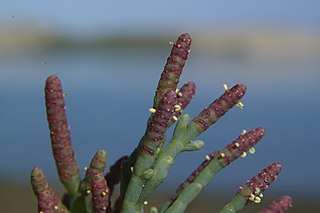
Salicornia pacifica, also known as pickleweed, sea asparagus, Pacific swampfire, or glasswort, is a species of low-growing perennial succulent halophyte in the genus Salicornia found in the Pacific coast of North America and California.

Salicornia rubra, the Rocky Mountain glasswort, is a species of flowering plant in the family Amaranthaceae. It is native to colder or higher areas of North America; the Yukon, Nunavut, British Columbia, Alberta, Saskatchewan, Manitoba, and Ontario in Canada, and the western and north-central United States. It has been introduced to Quebec and Michigan, and has gone extinct in Illinois. A halophyte, it is one of the most salt-tolerant plants of North America.

Salicornia fruticosa, synonym Sarcocornia fruticosa, is a species of glasswort in the family Amaranthaceae (pigweeds). It is native to southern Europe, north Africa, Western Asia and Yemen. It is a halophyte, a plant that can grow in saline conditions.

Salicornia maritima, the sea glasswort, is a succulent, salt-tolerant plant found along the eastern coast of North America, including Maine and New Brunswick.

